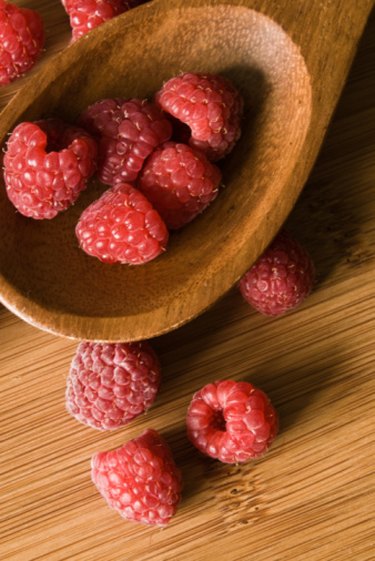
Raspberries are a relatively easy-to-grow fruit, requiring only decent soil, lots of sun, water and perhaps a little fertilizer. The resulting fruit is excellent fresh or added to desserts, and contains high levels of vitamin C and A. However, raspberries won't produce fruit if they don't first grow flowers, so if a raspberry plant is bloomless, it's important to determine the cause.
Is it Time?
Video of the Day
Raspberry plants are biennials. Therefore, gardeners should expect them to produce many canes their first year, then bloom and produce berries the next season. Once they produce fruit, the canes will die at the end of that year. However, new canes should also come up the second year, and will produce fruit in the plant's third year. To tell the difference between first- and second-year canes, just look at their color. First-year canes are green, while second-year canes have brown bark.
Video of the Day
Soil Quality and pH
According to the University of Maine Extension website, it can take up to two years for garden soil to be sufficient to grow healthy, blooming raspberry plants. If raspberries fail to produce flowers, test the soil near the plant using a home testing kit (available at gardening centers). Raspberries like a pH of 5.6 to 6.2. In addition, raspberries don't grow well in poorly draining or clay soil. Amending the soil can rectify both soil quality and pH levels.
Fertilizer
A home soil testing kit will also indicate if the earth around the raspberries is giving the plant adequate nutrition. If the soil is low in any of the essential nutrients, apply organic or synthetic fertilizer, according to the soil testing kit recommendations.
Sun Exposure
Raspberries require full sun — at least six hours per day -- in order to produce well. If gardeners are unsure how much sunlight is available to a raspberry plant, the easiest way to learn is to use an electronic sunlight meter, like SunCalc or Sunstick.
Proper Pruning
In order to produce flowers and fruit, raspberries must be pruned properly. Summer red raspberries need pruning two times each year; no later than early April, prune off all weak canes. Also cut back canes over 5 feet tall until they are about 4 ½ feet high. After harvest, remove all fruit-bearing canes. Everbearing red raspberries can be pruned similarly, producing two harvests. Alternatively, in April cut down all everbearing raspberries canes to the ground. Purple or black raspberries need pruning in March; cut all lateral branches to about 8 inches long. Prune black raspberries again when canes are 24 inches long, removing just 3 inches from the tips of all new shoots. Do the same when purple raspberry canes are 30 inches long. Finally, prune fruit-bearing black or purple raspberries immediately after harvest.